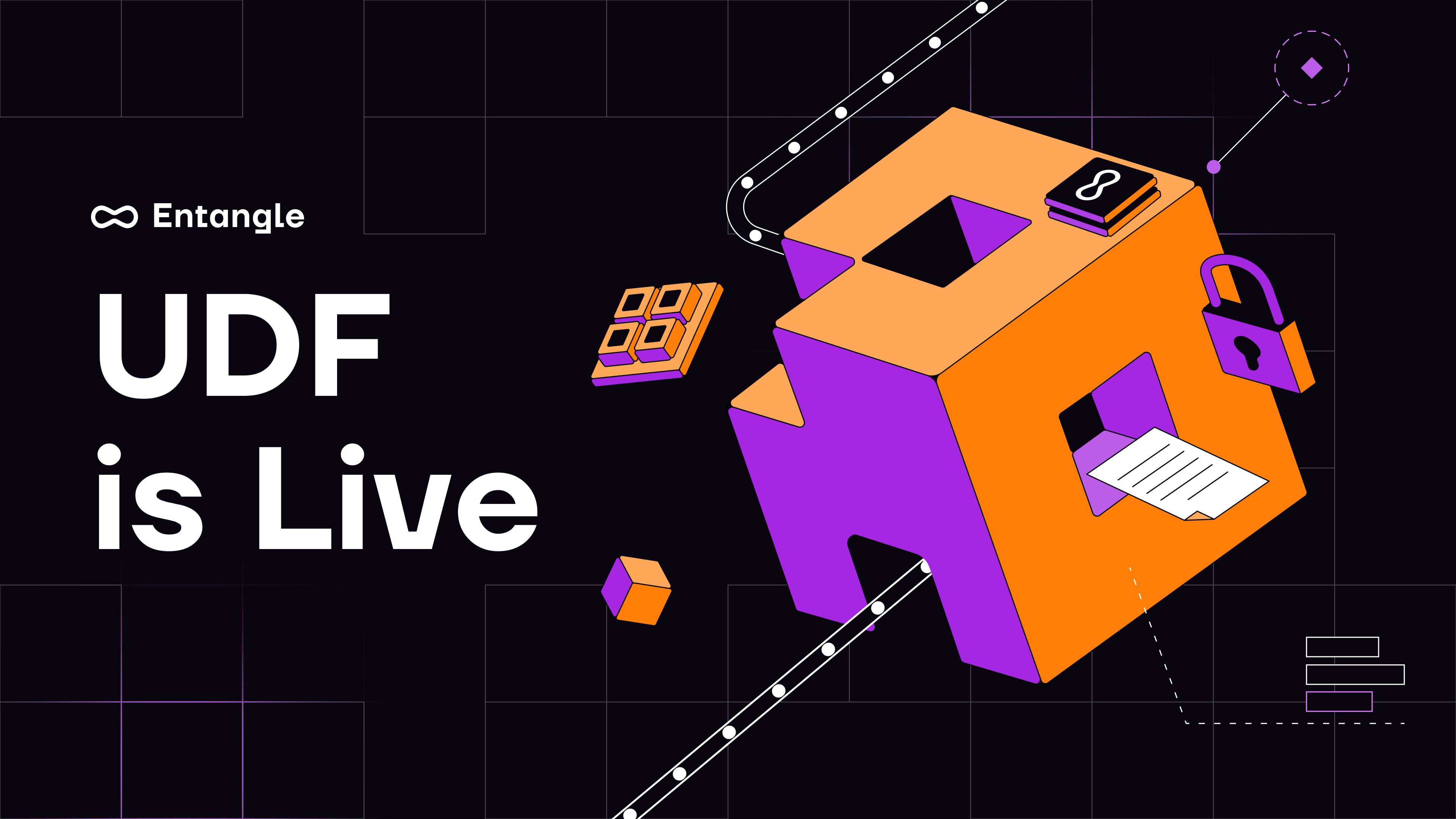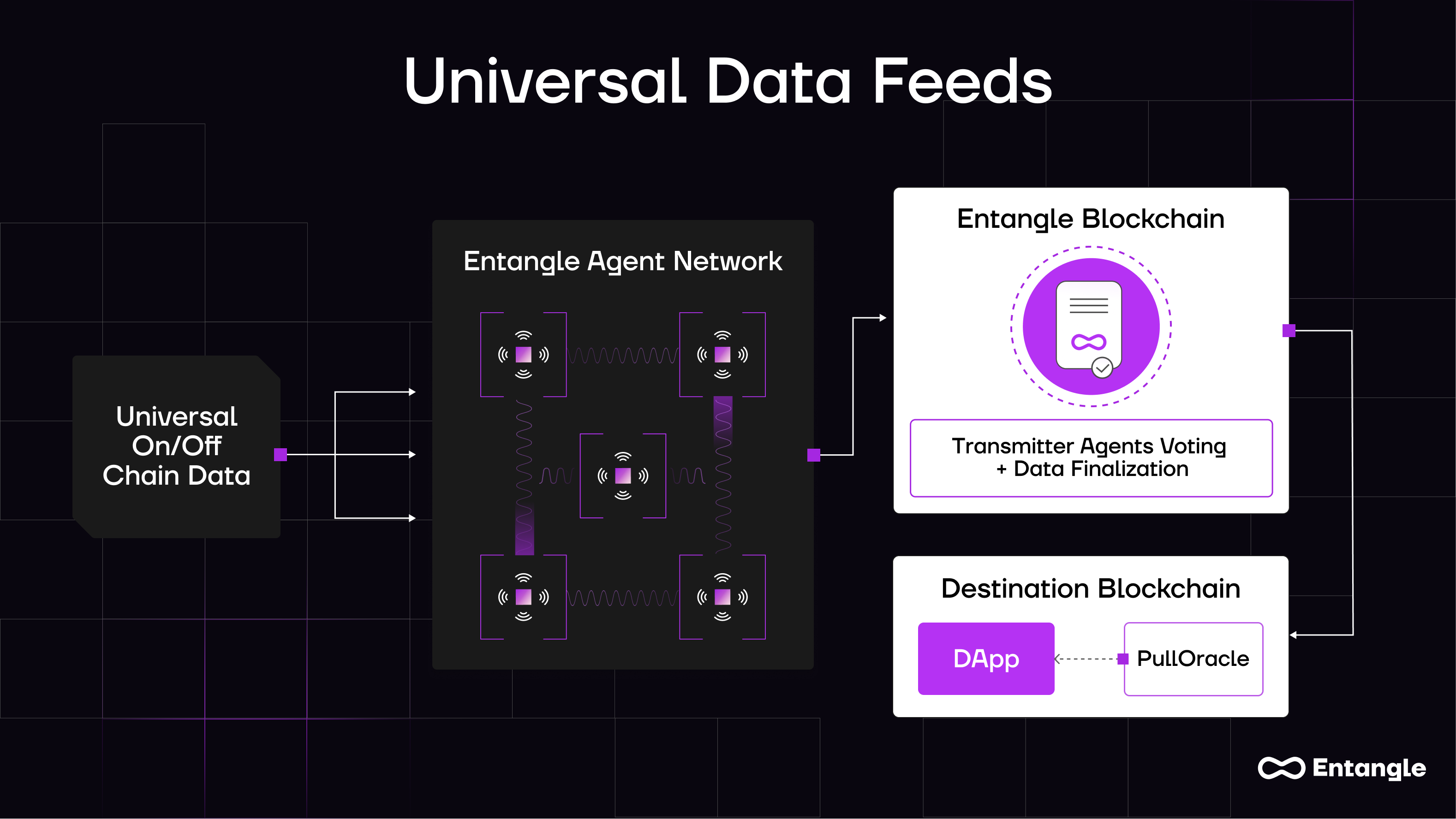Universal Data Feeds Is Live
Connecting data seamlessly, everywhere.

TL;DR: Entangle's Universal Data Feed (UDF) seamlessly integrates data from Web2 and Web3 sources, enhancing smart contract interactions across blockchain networks. UDF supports a range of use cases, including RWA, DeFi, AI, and IoT, offering secure, cost-effective, and customizable data feeds across any chain.
Smart contracts have changed how we manage value and information, giving people more control over their interactions with products and services. However, their effectiveness depends on the quality and timeliness of the data they receive.
Entangle's UDF standardizes and converts raw data from varied sources into a format that is universally accessible and actionable across different blockchain applications in both EVM and non-EVM networks. It enhances how developers, decentralized applications, and smart contracts interact with data.
Key Features of UDF
- Unified Collection and Processing: UDF allows decentralized applications to import data from any Web2 and Web3 source. Developers can define processing and finalization modules and choose dissemination schemes.
- Interoperability: UDF enables smart contracts to access data across any chain or source, working seamlessly with both EVM and non-EVM networks.
- Pull Model: UDF supports pull models for data delivery, accommodating needs for timely updates or cost-effective on-demand retrieval.
- Economic Model: Fees from data feeds are distributed among validators, transmitter agents, and delegates.
- Data Security: The Entangle Blockchain secures authenticated on-chain data storage, supported by over 100 validators and dual Proof-of-Collateral mechanics.
- Modularity: Our oracle system is built with exceptional modularity, designed to be "universal" by enabling integration with smart contracts across any blockchain. Developers can use customized feeds to source data from both Web3 and real-world (Web2) data sources.
Inside The Architecture

The operational flow for data feeds can be divided into the following stages:
- Data collection and processing
- Data finalization
- Data distribution
Data Collection and Processing
Entangle’s Transmitter Agent network preprocesses incoming data by fetching raw transactional data from various CEXs, storing it in local databases, aggregating trades by defined time intervals, and calculating the Volume-Weighted Average Price (VWAP).
This preprocessing stage ensures data is ready for further processing within the UDF protocol. The data collected is distributed into two buckets:
- Deterministic Data: Stored on-chain without additional processing due to its reliability
- Floating Data: Volatile data that requires preprocessing, such as aggregation and calculation, before blockchain incorporation.
Data Finalization
A specialized smart contract manages the finalization of data in the Entangle blockchain ecosystem. This process involves the following steps:
- Vote Collection: Transmitter Agents, who are responsible for gathering and preprocessing data, submit their votes on the data's value for a given round.
- Vote Validation: The system filters these votes to ensure they fall within an accepted range. This step ensures that only valid and reliable votes are considered.
- Price Determination: The contract calculates the final price by taking the median of all the valid votes. The median is chosen because it effectively represents the central value, minimizing the impact of any outliers.
- Reward Allocation: Votes that contribute to determining the final price are marked as rewardable. The Agents who provided these valid votes are then rewarded through a system that involves staking, where they have committed tokens to guarantee their performance and reliability.
This process ensures that the data used by decentralized applications is accurate and trustworthy, and it incentivizes participants to provide honest and reliable data by offering them rewards.
Data Distribution
Post-data finalization, the following steps occur to ensure accurate and timely data distribution:
- Event Detection: Transmitter Agents monitor the system for finalized data. Once detected, they assess whether a price revision is necessary based on current conditions.
- Price Revision: If a revision is needed, the Transmitter Agents submit new price votes to Entangle’s Master Smart Contract. This contract validates the votes, checks for consensus among the Agents, and triggers an update event if consensus is reached.
- Data Dissemination: An off-chain Executor agent detects the approved finalized data (or gets the updated price data from the Master contract) and sends it to the target smart contract.
This workflow ensures that data remains accurate, reliable, and timely, enhancing the functionality and efficiency of the smart contracts that rely on these data feeds.
UDF Use Cases
These use cases demonstrate how UDF enhances the functionality, reliability, and efficiency of various decentralized applications by ensuring access to accurate and timely data.
#1 Real-World Data
Entangle's UDF seamlessly integrates offchain real-world data with smart contracts, allowing developers to focus on functionality without data connectivity concerns. UDF facilitates the tokenization and management of real-world assets with real-time price feeds, ensuring accurate minting, redemption, and asset tracking.
#2 DeFi Apps
- Lending and Borrowing: UDF delivers real-time data feeds for issuing and settling loans, monitoring collateral, and triggering automated liquidations to maintain solvency and protect assets.
- Mirrored Assets: DeFi apps can use UDF's accurate and diverse data feeds to access CeFi data and create mirrored assets. UDF enables the creation, trading, and maintenance of synthetic assets on blockchains, and automates asset governance and collateral management processes.
- Restaking and Liquid Staking: Entangle's UDF highly modular price feeds can be easily adjusted for dynamic assets like LSTs and LRTs that require novel price discovery models and weighted averages.
#3 Proof of Reserves
Entangle's UDFs provide a robust solution for Proof of Reserve (PoR) feeds, supporting both offchain and cross-chain reserves. With a secure, customizable, and cost-effective data infrastructure, Entangle ensures reserve data is accurate, reliable, and accessible.
#4 AI
UDF can feed high quality data into AI models, enabling dynamic decision-making within dApps. For example, in supply chain management, AI can use UDF data to predict demand and optimize logistics for timely, cost-effective delivery.
#5 IoT
UDF can source real-time sensor data from IoT devices, enabling smart contracts to automate decisions based on this information.
UDF’s Advantages Over Traditional Oracles
- Cross-Chain Capabilities: Unlike traditional oracles, Entangle’s feeds disseminate data across various networks, not limited to a few blockchains.
- Data Authentication: By providing authenticated, verifiable on-chain data and mechanisms to verify integrity, Entangle’s feeds mitigate security risks and potential data manipulation.
- Modular Customizability: Entangle's UDF offers robust price feeds for any asset type, incorporating additional aggregation and processing logic. Developers can customize the data feeds to meet specific use cases. For example, UDF can provide price data from selected sources or preferred time-weighted averages, as per a protocol's requirements.
- Affordable: Entangle's UDFs are significantly more cost-effective due to superior data encoding techniques. By applying signatures to entire arrays of assets rather than individual updates, UDF achieves substantial savings while maintaining high data integrity.
Entangle's UDF excels in customizability, authentication, and versatility, meeting diverse user needs and unlocking a whole new world of use cases. UDF enhances dApp functionality and opens new avenues for a new paradigm where blockchain unites with the real world.